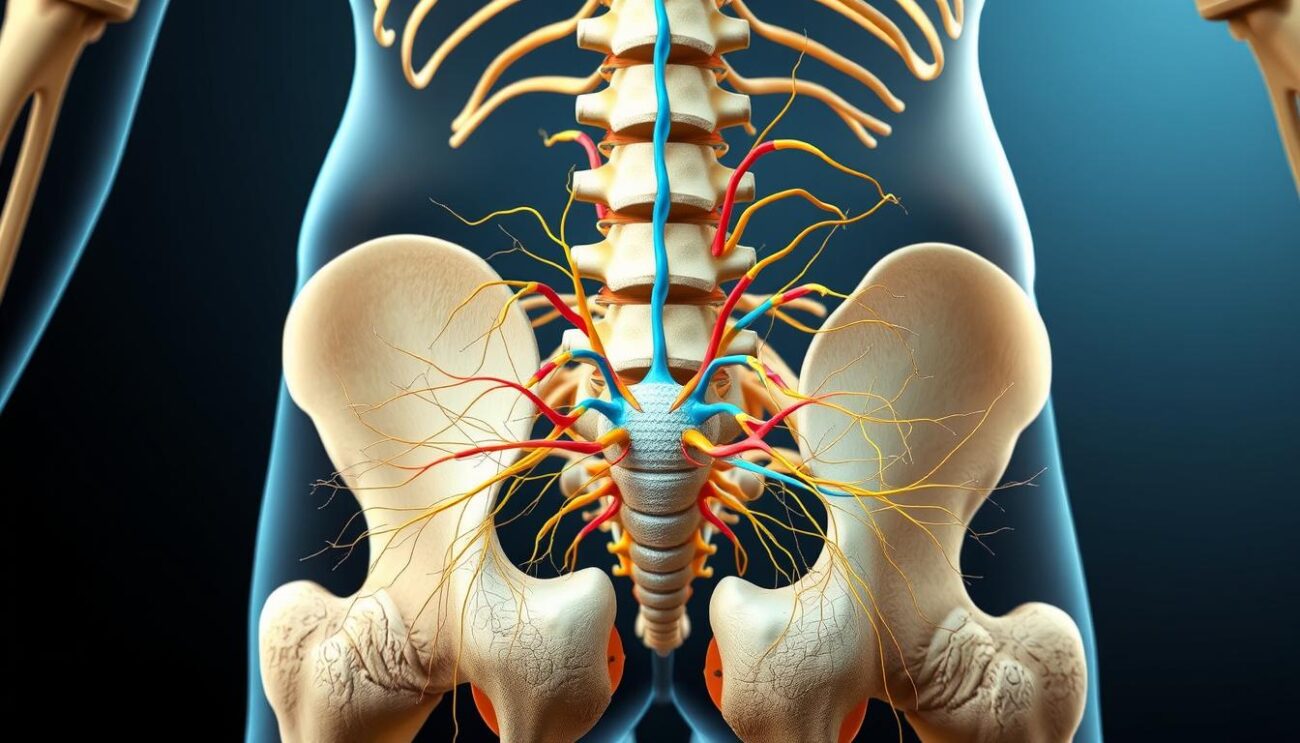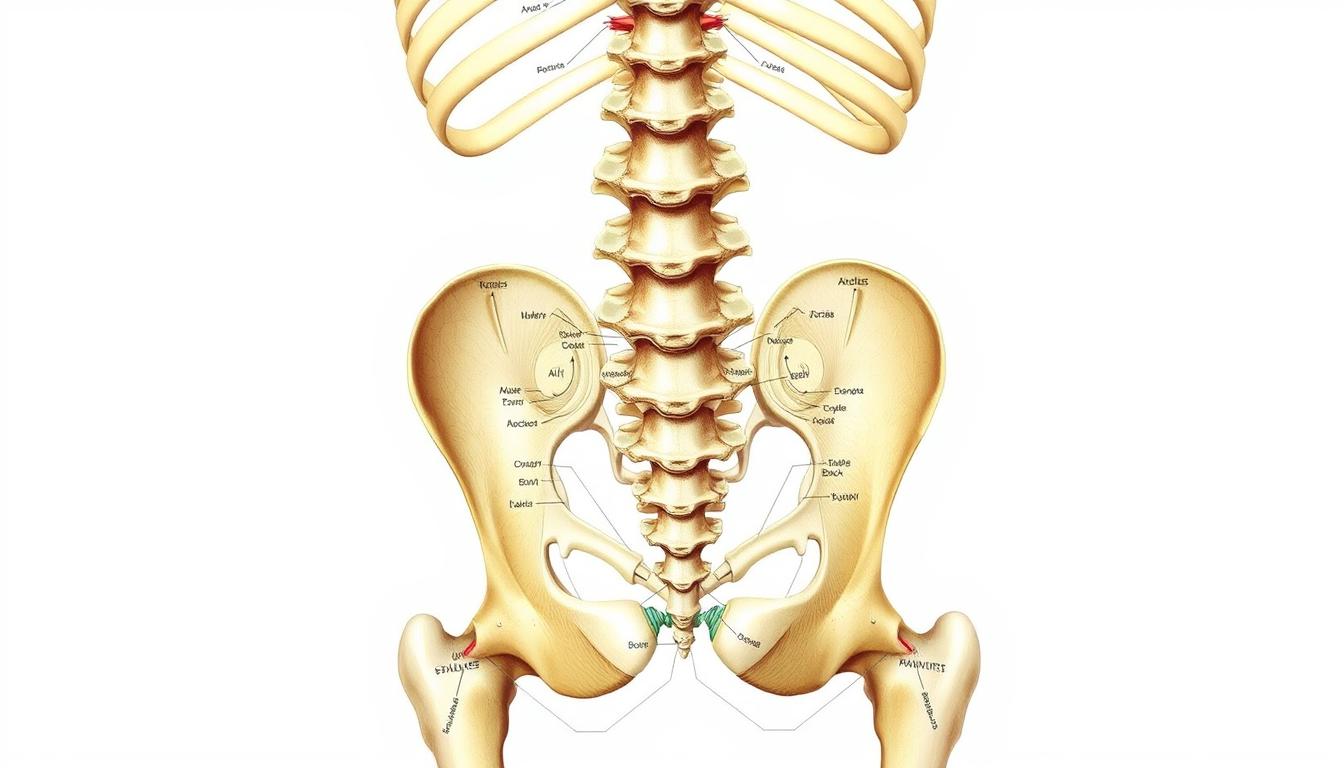Do you really know what the sacrum is, that bone at the base of your back? It is much more than just a support. The sacrum is crucial for the anatomy and mobility of your lower back . It also influences your posture and well-being.
The sacrum is formed by the fusion of five sacral vertebrae. It has an inverted triangular shape and a concave surface. This massive bone helps transmit the body’s weight. But it does more than just support your body.
It plays a key role in your health and well-being. Let’s explore its structure and functions to better understand its importance.
Find out how the sacrum can affect your
Introduction
The Spine: An Overview
The spine , or backbone, is essential for our body. It is made up of 33 vertebrae . These vertebrae protect the spinal cord and spinal nerves .
It supports the head, neck, thorax, abdomen and pelvis. Thanks to the intervertebral discs and zygapophyseal joints , it is flexible and mobile.
The spine is divided into several segments . There is the cervical region (7 vertebrae), the thoracic region (12 vertebrae), the lumbar region (5 vertebrae), the sacral region (5 fused vertebrae) and the coccygeal region (3 to 5 fused vertebrae).
Each vertebra has vertebral processes and a vertebral foramen . These elements allow the passage of the spinal cord and spinal nerves.
“The spine is a fascinating structure, both strong and flexible, which plays a vital role in maintaining our posture and mobility.”
Understanding the anatomy and functioning of the spine is crucial. It helps prevent and treat back problems. Let’s take a closer look at the sacrum , a key part of this spine.
Structure and function of the sacrum
The sacrum is an inverted triangular bone. It is composed of five fused sacral vertebrae. Its unique shape gives it key functions for our body.
Inside the sacrum is the sacral canal . This canal allows the spinal cord to pass to the lumbar vertebrae. The sacral foramina line this canal and allow the emergence of spinal nerves S1 to S4.
The upper part of the sacrum , the sacral promontory , articulates with the last lumbar vertebra (L5). This articulation is crucial for the transfer of forces from the lower limbs. The wings of the sacrum also articulate with the ilia , forming the sacroiliac joints .
| Characteristics of the sacrum | Data |
|---|---|
| Number of sacral vertebrae | Usually 5, but can vary from 4 to 6 |
| Fusion of the sacral vertebrae | Between 18 and 30 years old |
| Difference between men and women | The sacrum is wider in women |
| Common pathologies | Fractures, chordomas, sacrococcygeal teratomas |
The sacrum is essential for the stability of the spine. It also helps transmit loads from the lower limbs. Any abnormality can cause serious health problems.
“The sacrum, the true keystone of spinal statics, deserves special attention.”
Sacral sacrum: anatomical basis
Bony landmarks
The sacrum is a triangular, concave structure. It is formed by five fused sacral vertebrae. These anatomical landmarks are crucial to understanding this complex part of the skeleton.
The base of the sacrum joins the fifth lumbar vertebra . The apex of the sacrum joins the coccyx. The auricular surfaces articulate with the ilium, forming the sacroiliac joints .
The anterior and posterior surfaces of the sacrum are important for ligaments and muscles. The central canal continues to the 4th sacral foramen , forming the sacral hiatus .
| Bony landmark | Description |
|---|---|
| Base of the sacrum | Articulates with the 5th lumbar vertebra |
| Apex of the sacrum | Articulates with the coccyx |
| Auricular surfaces | Articulate with the ilium |
| Anterior surface | Provides areas of muscle and ligament attachment |
| Posterior surface | Provides areas of muscle and ligament attachment |
Understanding the bony landmarks of the sacrum is crucial. This helps to grasp its structure and functions in the skeleton.
Vascularization and lymphatics
The sacrum is an important bone for the stability and mobility of the spine. It is supplied by arteries and veins. Let’s see the main vascular and lymphatic elements of the sacrum.
Sacral arteries
The sacrum receives its blood supply from two sources. The median sacral artery , a branch of the abdominal aorta, runs down the midline. The lateral sacral arteries , which arise from the internal iliac artery, also supply this area.
Venous system
Venous drainage of the sacrum occurs through internal and external venous plexuses of the vertebral canal. These plexuses drain blood from the spinal veins.
Lymphatic system
Lymph nodes are located in the concavity of the sacrum. They drain lymph flow from the rectum and posterior pelvic wall.
| Vascular element | Origin | Route | Irrigated territory |
|---|---|---|---|
| Median sacral artery | Abdominal aorta | Midline of the sacrum | Sacrum |
| Lateral sacral arteries | Internal iliac artery | Lateral part of the sacrum | Sacrum |
| Venous plexus | Spinal veins | Interior and exterior of the vertebral canal | Sacrum |
| Lymph nodes | N / A | Concavity of the sacrum | Rectum and posterior pelvic wall |
In conclusion, the vascularization and lymphatic system of the sacrum are essential for its anatomical understanding.
Innervation
The sacrum is crucial for the innervation of the pelvic region and lower limbs. It houses the sacral plexus . This complex network of nerves innervate the muscles and skin of this area.
Muscles
Several important muscles attach to the sacrum. They are innervated by branches of the sacral plexus . Among them are the piriformis muscle , the coccygeus muscle , and part of the iliacus muscle on the anterior surface.
On the posterior surface, we find the gluteus maximus muscle , the lumbar multifidus muscle and the erector spinae muscle .
These muscles are essential for pelvic stability and locomotion. Their innervation by the sacral plexus ensures harmonious coordination.
“The sacrum is a key element in the innervation of the pelvic region and lower limbs, thanks to the sacral plexus which originates there.”

In conclusion, understanding the innervation of the sacrum is crucial. This includes the sacral plexus and sacral nerves . This helps to better understand the pathologies and treatments of this complex region.
Physiological variants
The sacrum has several interesting shapes. Sexual dimorphism of the sacrum shows that the sacrum is shorter and wider in women. This helps the baby pass more easily during childbirth.
Another variation is the presence of lumbosacral transitional vertebrae (LSVT) . This occurs when the L5 vertebra becomes part of the sacrum. Or when the S1 vertebra becomes a 6th lumbar vertebra, with only 4 sacral vertebrae.
There are other differences such as variations in the number of sacral foramens . There are also malformations such as sacral agenesis , sacral spina bifida and sacral rib .
These differences in the sacrum, although often without symptoms, can be important for health and should be considered in medical care.
Surgical considerations
Understanding the anatomy of the sacrum is crucial for surgeons. It helps avoid complications during certain operations. For example, during spinal interventions, anesthesia, obstetrics and forensics.
Des procédures comme la fixation transpédiculaire de S1 demandent une grande attention. De même, la fixation iliosacrale, le bloc épidural caudal et la mesure de la conjugaison obstétricale pendant l’accouchement nécessitent une expertise particulière.
Le traitement des fractures instables du bassin demande une grande expertise. Seuls quelques spécialistes dans des centres spécialisés peuvent le faire. Une étude de Holdsworth montre que 15 patients sur 27 n’ont pas pu reprendre leur travail après des traitements non chirurgicaux.
Les fractures du bassin touchent 5% des cas de fractures. Elles surviennent dans 20% des cas de polytraumatismes. La classification de Young et Burgess aide à distinguer différents types de fractures, chacun avec des complications spécifiques.
Les complications après un traitement non chirurgical peuvent inclure des douleurs persistantes et des boiteries. Les pseudarthroses sont également possibles. Letournel souligne l’importance d’une réduction parfaite des fractures du bassin, même si cela est rarement possible.
La fixation définitive de l’anneau pelvien vise à rétablir la solidité de la charnière sacro-iliaque. Des techniques comme la fixation externe ou des plaques vissées sont utilisées. Les abords chirurgicaux, comme l’abord ilio-inguinal selon Judet Letournel, peuvent être complexes en raison de l’anatomie et de la proximité des vaisseaux et des nerfs.
Le vissage sacro-iliaque est une technique chirurgicale pour les ruptures instables de l’anneau pelvien. Elle utilise la fluoroscopie et est adoptée dans les pays avancés.
| Statistiques clés | Valeurs |
|---|---|
| Nombre de numéros publiés par an dans Revue Médicale Suisse | 43 |
| Public cible | Médecins de soins primaires, spécialistes de diverses disciplines médicales, médecins résidents, chefs de clinique, étudiants et autres professionnels de santé de la communauté médicale francophone |
| Domaines couverts | Médecine interne générale |
| ISSN | 1660-9379 |
| Affiliation éditoriale | Médecine et Hygiène |
| Durée de l’abonnement | 12 mois |
« Le vissage sacro-iliaque est une technique chirurgicale utilisée pour traiter les ruptures instables de l’anneau pelvien, basée sur l’utilisation de la fluoroscopie et adoptée dans les pays avancés. »
Importance clinique
Fractures de fatigue du sacrum
Les fractures du sacrum peuvent arriver dans le sport, appelées “fractures de fatigue”. Elles peuvent aussi se produire après un grand choc. La guérison prend généralement 4 mois.
Ces fractures sont souvent légères, mais peuvent causer des problèmes nerveux. Heureusement, la plupart guérissent bien avec le bon traitement. Les douleurs se sentent surtout dans le bas du dos et peuvent monter jusqu’à la cuisse.
Le kinésithérapie aide à guérir ces fractures. On utilise des massages, des exercices pour renforcer les muscles, et des étirements.
Insufficiency fractures of the sacrum result from normal force on a weak bone. This often occurs in people with osteoporosis . Other risks include pelvic radiation therapy and rheumatoid arthritis .
” Sacral fractures are often trivial, but sometimes have associated neurological injuries.”
Sacroiliac insufficiency fractures
Sacral fractures are divided into two main types. Insufficiency fractures occur when the sacral bone is weak or diseased. They often occur in older people, due to osteoporosis .
Insufficiency fractures of the sacrum occur when a weak bone is subjected to normal pressure. Risk factors include osteoporosis , pelvic radiation therapy , and rheumatoid arthritis . These fractures cause pain when pressure is applied to the sacrum.
Fatigue fractures of the sacrum are rare and mainly affect young people and athletes. Insufficiency fractures, on the other hand, represent about 5% of fractures. They often occur in a context of polytrauma.
Treatment may include bed rest or rapid mobilization. In some cases, injection of cement into the sacrum is considered. Open surgery is rarely necessary, but percutaneous fixation allows for rapid recovery.
Conclusion
The sacrum is very important to the body. It supports weight and helps transmit forces. But, its position and proximity to other structures can cause problems.
Doctors should understand the importance of the sacrum . This helps to better treat patients with problems in this area.
Sacral problems can be serious. They include fractures, circulation and nerve problems. Anatomical changes can also affect its stability and mobility.
It is crucial to recognize these problems early. Good management can prevent serious consequences for the patient.
In summary, having a good understanding of the anatomy and functions of the sacrum is essential. It helps physicians better understand and treat sacral-related complications . This improves the quality of care and patient outcomes.



